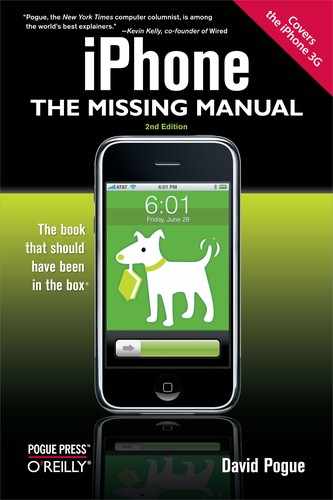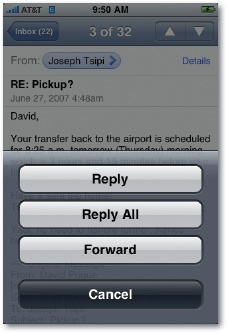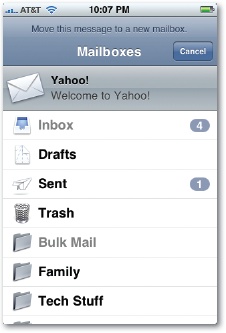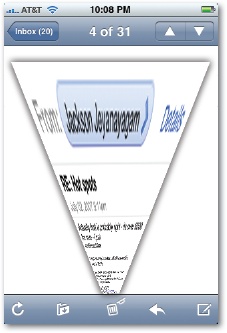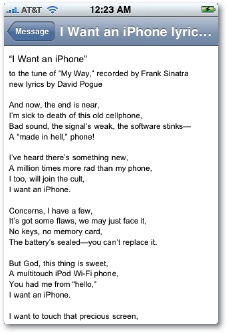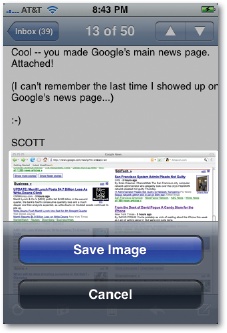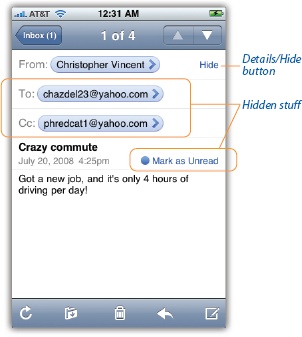Once you've viewed a message, you can respond to it, delete it, file it, and so on. Here's the drill.
The type size in email messages can be pretty small. Fortunately, you have some great iPhoney enlargement tricks at your disposal. For example:
Spread two fingers to enlarge the entire email message (Pinch and Spread).
Double-tap a narrow block of text to make it fill the screen, if it doesn't already.
Drag or flick your finger to scroll through or around the message.
Tip
You can also, of course, just ask the iPhone to use a larger type size. From the Home screen, tap Settings→Mail, Contacts, Calendars→Minimum Font Size. You can choose the minimum type size you want from these options: Small, Medium, Large, Extra Large, or Giant. (What, no Humongous?)
It's nice to note that links are "live" in email messages. Tap a phone number to call it; a Web address to open it; a YouTube link to watch it; an email address to write to it; and so on.
Tip
If you' re using a Gmail account—a great idea—then any message you send, reply to, delete, or file into a folder is reflected on the Web at Gmail.com. Whether deleting a message really deletes it (after 30 days) or adds it to Gmail's "archived" stash depends on the tweaky settings described at http://tinyurl.com/yokd27.
To answer a message, tap the Reply/Forward icon (![]() ) at the bottom of the screen. You're asked if you want to Reply or Forward; tap Reply. If the message was originally addressed to multiple recipients, you can send your reply to everyone simultaneously by hitting Reply All instead.
) at the bottom of the screen. You're asked if you want to Reply or Forward; tap Reply. If the message was originally addressed to multiple recipients, you can send your reply to everyone simultaneously by hitting Reply All instead.
A new message window opens, already addressed. As a courtesy to your correspondent, Mail places the original message at the bottom of the window.
At this point, you can add or delete recipients, edit the Subject line or the original message, and so on.
Tip
Use the Return key to create blank lines in the original message. (Use the Loupe—Making the Keyboard Work—to position the insertion point at the proper spot.)
Using this method, you can splice your own comments into the paragraphs of the original message, replying point by point. The brackets preceding each line of the original message help your correspondent keep straight what's yours and what's hers.
When you're finished, tap Send.
Instead of replying to the person who sent you a message, you may sometimes want to pass the note on to a third person.
To do so, tap the ![]() button at the bottom of the screen. This time, tap Forward.
button at the bottom of the screen. This time, tap Forward.
Tip
If there's a file attached to the inbound message, the iPhone says, "Include attachments from original message?" and offers Include/Don't Include buttons. Rather thoughtful, actually—the phone can pass on files that it can't even open.
A new message opens, looking a lot like the one that appears when you reply. You may wish to precede the original message with a comment of your own, along the lines of, "Frank: I thought you'd be interested in this joke about your mom."
Finally, address and send it as you would any outgoing piece of mail.
As noted earlier, some mail accounts let you create filing folders to help manage your messages. Once you've opened a message that's worth keeping, you file it by tapping the ![]() button at the bottom of the screen. Up pops the list of your folders next page, left); tap the one you want.
button at the bottom of the screen. Up pops the list of your folders next page, left); tap the one you want.
It's a snap to delete a message you no longer want, too. If it's open on the screen before you, simply tap the ![]() button at the bottom of the screen. Frankly, it's worth deleting tons of messages just for the pleasure of watching the animation as they funnel down into that tiny icon, whose lid pops open and shut accordingly (next page, right).
button at the bottom of the screen. Frankly, it's worth deleting tons of messages just for the pleasure of watching the animation as they funnel down into that tiny icon, whose lid pops open and shut accordingly (next page, right).
You can also delete a message from the message list—the Inbox, for example. Just swipe your finger across the message listing, in either direction. (It doesn't have to be an especially broad swipe.) The red Delete button appears; tap it to confirm, or tap anywhere else if you change your mind.
There's a long way to delete messages from the list, too—tap Edit, tap ![]() , tap Delete, and then tap Done—but the finger-swipe method is much more fun.
, tap Delete, and then tap Done—but the finger-swipe method is much more fun.
Tip
If that one-touch Delete method makes you a little nervous, you can ask the iPhone to display a confirmation box before trashing the message forever. See Contacts.
You can also file or delete a bunch of messages at once. In the message list, tap Edit. Suddenly, a circle appears beside each message title.
You can tap as many of these circles as you like, scrolling as necessary, adding a checkmark with each touch.
Finally, when you've selected all the messages in question, tap either Delete or Move. (The number in parentheses shows how many you've selected).
If you tap Move, you're shown the folder list so you can say where you want them moved. If you tap Delete, the messages disappear.
Note
When you delete a message, it goes into the Deleted folder. In other words, it works like the Macintosh Trash or the Windows Recycle Bin. You have a safety net.
Email doesn't have to stay in the Deleted folder forever, however. You can ask the iPhone to empty that folder every day, week, or month. From the Home screen, tap Settings→Mail, Contacts, Calendars. Tap your account name, then Account Info→Advanced→Remove. Now you can change the setting from "Never" to "After one day" (or week, or month).
If you get a message from someone new who's worth adding to your iPhone's Contacts address book, tap the blue, oval-shaped email address (where it says "From:"). You're offered two buttons: Email (meaning, "Reply") and Create New Contact. Use that second button if you think you may one day want to write this person back.
The Mail program downloads and displays the icons for any kind of attachment—but it can open only documents from Microsoft Office (Word, Excel, PowerPoint), Apple iWork (Pages, Keynote, Numbers), PDF, graphics, and un-copy-protected audio and video files.
Just scroll down, tap the attachment's icon, wait a moment for downloading, and then marvel as the document opens up, full-screen. You can zoom in and zoom out, flick, rotate the phone 90 degrees, and scroll just as though it's a Web page or photo.
You just can't edit it.
When you're finished admiring the attachment, tap Message (top-left corner) to return to the original email message.
One of the great joys of iPhone mail is its ability to display graphics that the sender embedded right in the message. And one of the great joys of the iPhone 2.0 software is its ability to save these graphics onto your phone, for reusing and re-enjoying later.
Just hold your finger still on the picture until the Save Image button slides up from the bottom of the screen. Tap Save Image. (To see it later, tap Photos on the Home screen, and then tap Camera Roll.)
When your computer's screen measures only 3.5 inches diagonally, there's not a lot of extra space. So Apple designed Mail to conceal the details that you might need only occasionally. They reappear, naturally enough, when you tap Details in the upper-right corner of a message.
Now you get to see a few more details about the message. For instance:
Who it's to. Well, duh—it's to you, right?
Yes, but it might have been sent to other people, too. When you open the Details, you see who else got this note—along with anyone who was Cc'ed (sent a copy).
Mark as Unread. In the Inbox, any message you haven't yet read is marked by a blue dot (
 ). Once you've opened the message, the blue dot goes away.
). Once you've opened the message, the blue dot goes away.By tapping Mark as Unread, however, you make that blue dot reappear. It's a great way to flag a message for later, to call it to your own attention. The blue dot can mean not so much "unread" as "un-dealt with."
Tap Hide to collapse these details.
